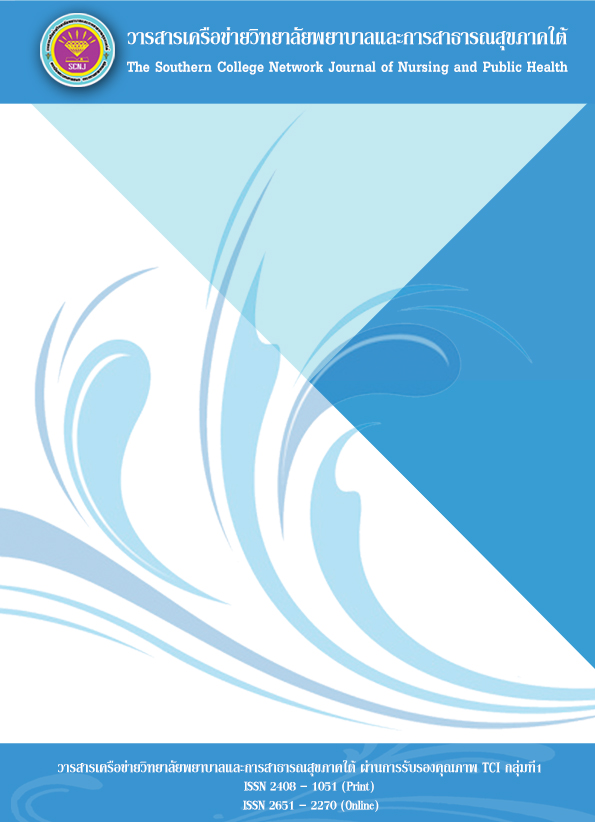ผลของโปรแกรมทันตสุขศึกษาสำหรับผู้ปกครอง ในการป้องกันฟันผุของเด็กปฐมวัย ศูนย์พัฒนาเด็กเล็ก ตำบลโคกยาง อำเภอกันตัง จังหวัดตรัง
คำสำคัญ:
ฟันผุ, เด็กปฐมวัย, ผู้ปกครอง, การป้องกันบทคัดย่อ
การศึกษาวิจัยครั้งนี้มีรูปแบบการวิจัยกึ่งทดลอง มีวัตถุประสงค์เพื่อศึกษาผลของโปรแกรมทันตสุขศึกษาสำหรับผู้ปกครอง ในการป้องกันฟันผุของเด็กปฐมวัย ศูนย์พัฒนาเด็กเล็ก ตำบลโคกยาง อำเภอกันตัง จังหวัดตรังเก็บรวบรวมข้อมูลตั้งแต่ เดือนธันวาคม 2559-มกราคม 2560 ประชากรทั้งหมด 147 คน ใช้วิธีสุ่มอย่างง่ายโดยจับฉลากแบบไม่ใส่คืน กลุ่มตัวอย่างทั้งหมด 42 คน แบ่งเป็นกลุ่มทดลอง จากศูนย์พัฒนาเด็กเล็กโคกยาง 21 คน และกลุ่มควบคุม จากศูนย์พัฒนาเด็กเล็กหนองเหม้า 21 คน กลุ่มทดลองได้รับโปรแกรมทันตสุขศึกษาโดยการทำกิจกรรมกลุ่ม การสอนให้คำแนะนำ การสาธิต การแสดงบทบาทสมมุติ เล่นเกม ดูวิดีโอที่เกี่ยวข้องการป้องกันฟันผุของเด็กปฐมวัย ส่วนกลุ่มควบคุม ได้รับเอกสารความรู้ในการป้องกันฟันผุสำหรับเด็กปฐมวัย ระยะเวลาดำเนินการ 4 สัปดาห์ วิเคราะห์ข้อมูลโดยใช้สถิติ t-test ผลการศึกษาพบว่า
1. ในกลุ่มทดลอง กลุ่มตัวอย่างมีคะแนนความรู้ และพฤติกรรมในการป้องกันฟันผุก่อนเข้าร่วมโปรแกรมอยู่ในระดับปานกลาง (M=11.29 SD=1.82 และ M=28.38, SD=3.76 ตามลำดับ) และความรู้ และพฤติกรรมหลังเข้าร่วมโปรแกรมอยู่ในระดับสูง (M=14.43, SD=1.10 และ M=33.90, SD=4.06 ตามลำดับ)
2. ในกลุ่มควบคุม กลุ่มตัวอย่างมีคะแนนความรู้ และพฤติกรรมในการป้องกันฟันผุก่อนเข้าร่วมโปรแกรมอยู่ในระดับปานกลาง (M=11.14, SD=1.88 และ M=27.95, SD=6.21 ตามลำดับ) และความรู้ และพฤติกรรมหลังเข้าร่วมโปรแกรมอยู่ในระดับปานกลาง (M=12.05, SD=1.24 และ M =28.19, SD=5.93 ตามลำดับ)
3. หลังจากได้รับโปรแกรม กลุ่มทดลองมีความรู้ และพฤติกรรมในการป้องฟันผุสูงขึ้นอย่างมีนัยสำคัญทางสถิติที่ระดับ 0.05 (p<001 และ p=0.001 ตามลำดับ) ในขณะที่กลุ่มควบคุมมีความรู้และพฤติกรรมในการป้องกันฟันผุ ไม่แตกต่างกันอย่างมีนัยสำคัญทางสถิติที่ระดับ 0.05 (p-value =0.832 และ p=0.113 ตามลำดับ) ความรู้ และพฤติกรรมในการป้องฟันผุระหว่างกลุ่มทดลองกับกลุ่มควบคุมแตกต่างกันอย่างมีนัยสำคัญทางสถิติที่ระดับ 0.05 (p<0.001 และ p=0.001 ตามลำดับ)
ศูนย์พัฒนาเด็กเล็กที่อื่นสามารถนำโปรแกรมทันตสุขศึกษานี้ ไปประยุกต์ใช้ให้เหมาะสมกับบริบทของพื้นที่ อย่างไรก็ตามการนำโปรแกรมนี้ไปใช้อาจมีวิธีการที่ประยุกต์ที่แตกต่างกันเนื่องจากลักษณะทางสังคมและวัฒนธรรมที่ต่างกัน
เอกสารอ้างอิง
Best, & John, W. (1977). Research in Education. (3 rd ed.). New Jersey: Prentice Hall, Inc.
Bloom, B. S. (1986). Learning for Mastery Evaluation Comment. Center for the Study of Instruction Promgrame. Univercity of California at Los Angeles.
Cohen, J. (1988). Statistical Power Analysis for the Behavioral Sciences (2nd ed.). New Jersey: Lawrence Earlbaum Associates.
Dental Health Division. (2012). The 7th National Oral Health Survey of Thailand Report. Nonthaburi: Department of Health, Ministry of Public Health. (in Thai)
Katepongpan, S., Hintao, J., & Yoonwong, N. (2014). Efficacy of The Sweet Enough Network Project in Trang on Sweetened Food Consumption among Children Aged 3–5 Years. Songklanakarin Dent, 2.1(1), 14-29. (in Thai)
Naree, S. (2013). The Effects of Dental Health Education Program by the Application of Health Belief Model and Social Support Theory for Behavioral Modification about Gingivitis Prevention among Students at Grade 1 Secondary School, Ubonrattana District, Khon Kaen Province. PhD. thesis. Khon Kaen: Khon Kaen University. (in Thai).
Narksawat, K., Boonthum, A., & Tonmukayakul. (2011). Roles of Parents in Preventing Dental Caries in the Primary Dentition Among Preschool Children in Thailand. Asia Pacific Journal of Public Health, 23(2), 209-16.
Office of Public Health, Trang Province. (2016). The Oral Health Status of Trang People in 2016. Trang: Document Reproduction. (in Thai).
Patrícia Corrêa-Faria, Anelise Daher, Maria do Carmo Matias Freire, Mauro Henrique Nogueira Guimarães de Abreu, Marcelo Bönecker and Luciane Rezende Costa. (2018). Impact of Untreated Dental Caries Severity on the Quality of Life of Preschool Children and Their Families: a Cross-Sectional Study, Quality of Life Research, 27(12), 3191-3198.
Pinitkit. (2016). The Effects of a Dental Health Education Program Toward Parents, Oral Health Care Behavior of Preschoolers. Thailand Journal of Dental Public, 21(2), 20-27.
Schroth, R. J., Harrison, R. L, & Moffatt, M. E. (2009). Oral health of Indigenous Children and the Influence of Early Childhood Caries on Childhood Health and Well-Being. Pediatr Clin North Am, 56, 1481–1499.
Sheiham, A. (2006). Dental Caries Affects Body Weight, Growth and Quality of Life in Pre-School Children. British Dental Journal, 201(10), 625-626.
Renata, S., Guedes, Thiago, M., Ardenghi, Chaiana Piovesan, Bruno Emmanuelli, & Fausto, M. Mendes. (2016). Influence of Initial Caries Lesions on Quality of Life in Preschool Children: a 2 Year Cohort Study, Community Dentistry and Oral Epidemiology, 44(3), 292-300.
Thammasarn, S. (2009). The Dental Care Behavior Modification for Parents of 3-4 Year-old Children for Tooth Decay Protection by Applications of Protection Motivation Theory and Social Support in Amphoe Pathum Ratchawongsa, Changwat Amnat Charoen. PhD thesis Mahasarakham: Mahasarakham University. (in Thai).
Weinstein, P., Harrison, R., & Benton, T. (2006). Motivating Mothers to Prevent Caries: Confirming the Beneficial Effect of Counseling. J Am Dent Assoc, 137, 789-793.
Wong, S. T. (2006). The Relationship Between Parent Emotion, Parent Behavior, and Health Status of Young African American and Latino children. J Pediatr Nurs, 21(6), 434-42.
ดาวน์โหลด
เผยแพร่แล้ว
ฉบับ
ประเภทบทความ
สัญญาอนุญาต
1. บทความหรือข้อคิดเห็นใด ๆ ที่ปรากฏในวารสารเครือข่าย วิทยาลัยพยาบาลและการสาธารณสุขภาคใต้ ที่เป็นวรรณกรรมของผู้เขียน บรรณาธิการหรือเครือข่ายวิทยาลัยพยาบาลและวิทยาลัยการสาธารณสุขภาคใต้ ไม่จำเป็นต้องเห็นด้วย
2. บทความที่ได้รับการตีพิมพ์ถือเป็นลิขสิทธิ์ของ วารสารเครือข่ายวิทยาลัยพยาบาลและการสาธารณสุขภาคใต้








